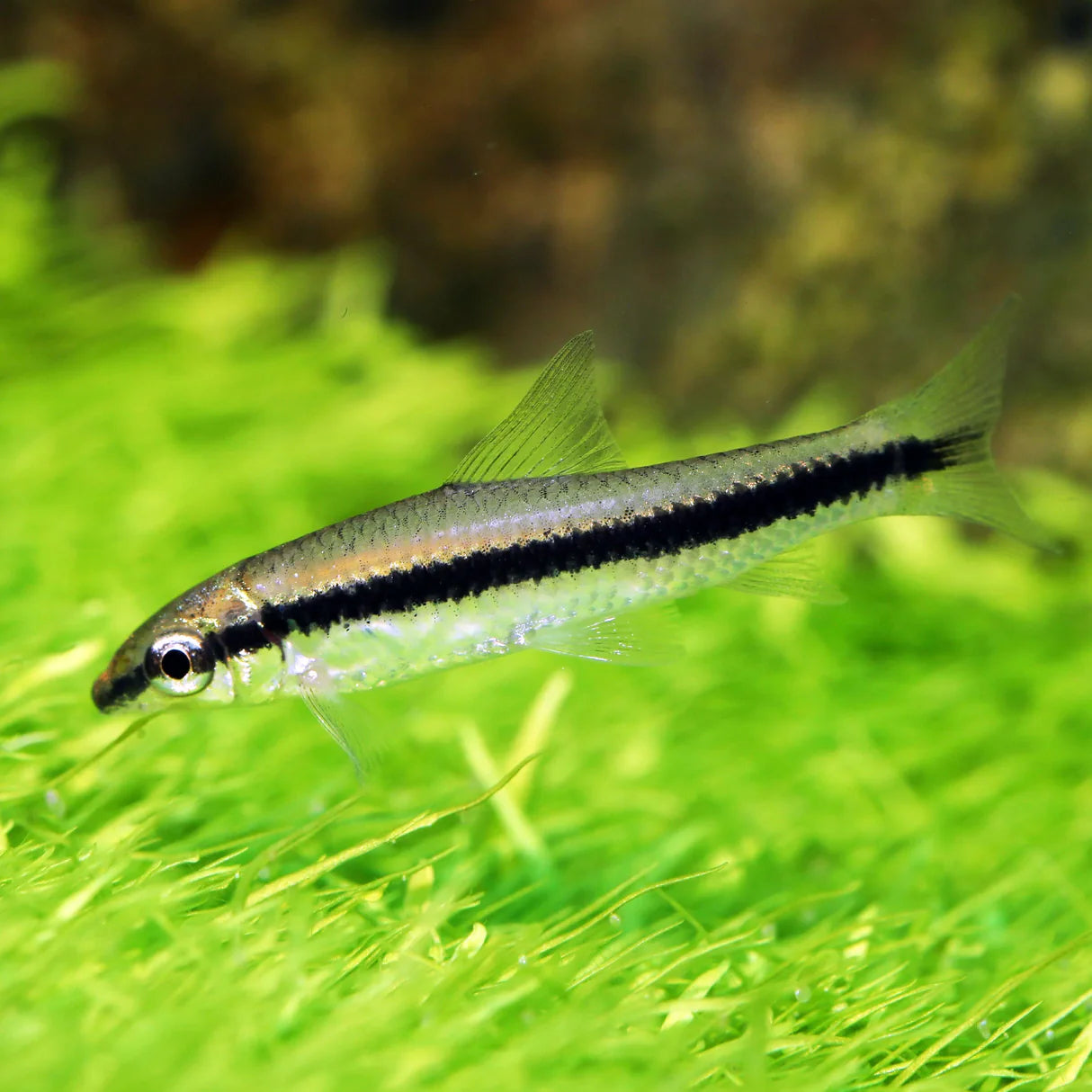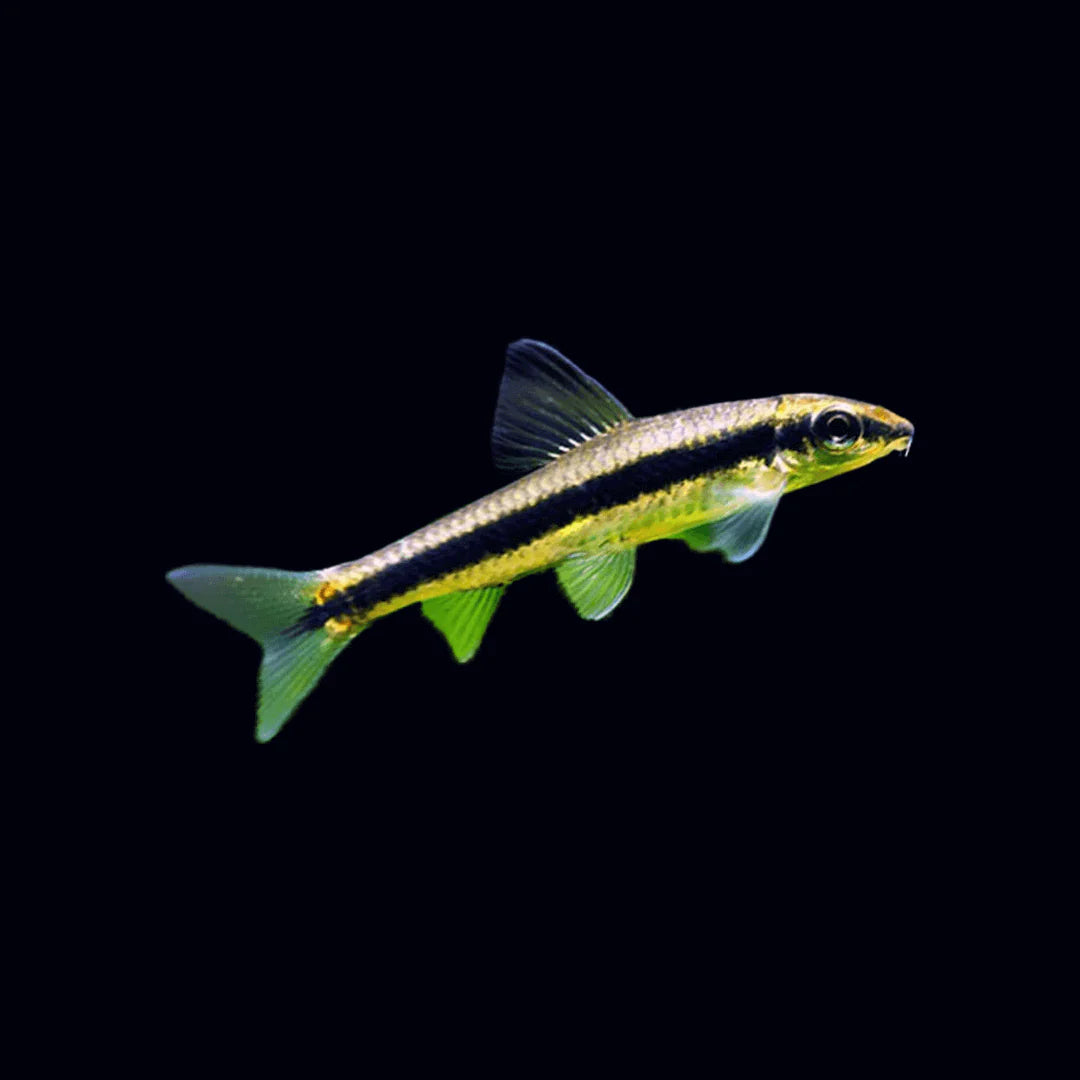Veda Aquarium
Siamese Algae eater | Single
Siamese Algae eater | Single
Couldn't load pickup availability
Golden Algae Eaters (Gyrinocheilus aymonieri), also known as Golden Chinese Algae Eaters, are a popular freshwater fish species valued for their striking golden coloration and algae-eating capabilities. They are hardy fish that can adapt to a variety of water conditions, making them suitable for beginner and experienced aquarists alike. However, their temperament can shift as they grow, so careful tank planning is essential.
Key Characteristics of Golden Algae Eaters:
Size: Typically grow to around 4–6 inches (10–15 cm) in aquariums but can reach up to 10 inches (25 cm) in larger tanks.
Color: They have a vibrant golden-yellow body, sometimes with a light stripe or pattern running along their side.
Lifespan: They live for about 5–10 years with proper care.
Temperament: While young fish are peaceful, they can become territorial and semi-aggressive as they mature, especially toward other bottom dwellers or fish with similar body shapes.
Behavior: Golden Algae Eaters are active grazers and spend much of their time clinging to surfaces like rocks, plants, or aquarium glass. They prefer low- to mid-tank areas and can be reclusive when stressed.
Water Parameters for Golden Algae Eaters:
Temperature: 22–28°C (72–82°F). They prefer stable, warm tropical water conditions.
pH: 6.0–8.0. They can tolerate a wide range of pH levels, though neutral to slightly alkaline water is ideal.
Hardness: 5–20 dGH (degrees of general hardness). They are adaptable to varying water hardness levels.
Ammonia & Nitrite Levels: Must always be 0 ppm, as these fish are sensitive to poor water quality.
Nitrate Levels: Should be kept below 20 ppm to ensure long-term health.
Aquarium Setup:
Tank Size: A minimum of 30 gallons is recommended for one Golden Algae Eater. Larger tanks (50+ gallons) are needed for multiple individuals or if kept with other bottom dwellers due to their territorial nature.
Substrate: Fine gravel or sand is ideal. They don’t burrow but may sift through the substrate while foraging.
Filtration: A powerful filter is recommended, as they thrive in well-oxygenated water with moderate to strong flow.
Plants & Decor: Provide plenty of hiding spots using rocks, driftwood, and live plants to help them feel secure and reduce stress. They may graze on biofilm but generally leave most plants intact.
Lighting: Moderate lighting is sufficient. Too much light can encourage excessive algae growth, which they may help control.
Diet:
While Golden Algae Eaters are excellent algae grazers, especially when young, they require a varied diet as they age:
Algae: They feed on soft green algae, though they may not consume harder types like black beard algae.
Vegetables: Blanched vegetables such as zucchini, spinach, or cucumber can supplement their diet.
Commercial Food: Algae wafers, sinking pellets, or herbivore-specific flakes provide balanced nutrition.
Protein Sources: Occasional live or frozen foods, like bloodworms or brine shrimp, can be offered sparingly. Too much protein can harm their digestive system.
Caution: As they mature, they may show less interest in algae and prefer prepared foods.
Tankmates for Golden Algae Eaters:
Golden Algae Eaters can coexist peacefully with certain species, but their semi-aggressive behavior must be considered:
Suitable Tankmates:
Mid-water swimmers like tetras, barbs, danios, and gouramis.
Peaceful species like rasboras and livebearers (guppies, mollies, platies).
Larger fish like angelfish or rainbowfish (if the tank is big enough).
Avoid Tankmates:
Other bottom dwellers (e.g., Corydoras, loaches) that may compete for territory.
Slow-moving or long-finned fish (e.g., bettas, fancy goldfish) that may be nipped at.
Aggressive species that could provoke territorial disputes.
Breeding Golden Algae Eaters:
Breeding Golden Algae Eaters in home aquariums is extremely challenging and rarely occurs naturally. They are typically bred in commercial fish farms using hormones. However:
Sexual Dimorphism: Males may develop tubercles (small bumps) on their head during breeding seasons, but distinguishing sexes is difficult.
Breeding Behavior: These fish are egg-layers, but their territorial tendencies and tank conditions often prevent successful spawning.
Benefits of Golden Algae Eaters in the Aquarium:
Algae Control: Young Golden Algae Eaters are efficient at cleaning algae from tank surfaces, decorations, and plants.
Hardiness: They are resilient and can adapt to a wide range of water parameters, making them suitable for beginners.
Activity: Their active grazing and bottom-dwelling behavior add life and movement to the tank.
Potential Challenges:
Territorial Behavior: As they mature, Golden Algae Eaters can become aggressive, especially toward their own kind or similar species.
Diet Shift: Older individuals may lose interest in algae and require more varied foods.
Size: Their eventual size and activity level mean they need a spacious tank.
Conclusion:
Golden Algae Eaters are a hardy and beautiful addition to aquariums, especially for their algae-eating abilities in their younger stages. With proper care, including a spacious tank, suitable tankmates, and a balanced diet, they can thrive and bring utility and aesthetic value to your tank. However, their temperament and size require thoughtful planning for long-term success.
The Red Cherry Barb (Pethia padamya), also known as the Burmese Cherry Barb, is a vibrant freshwater fish known for its striking red coloration and peaceful temperament. Originally found in Myanmar's slow-moving rivers and streams, these hardy fish are ideal for both beginner and experienced aquarists. Their shoaling nature and active swimming habits make them a lively addition to community tanks.
Key Characteristics of Red Cherry Barbs:
- Size: Grows up to 2 inches (5 cm) in length.
- Color: Males are bright cherry red, especially during spawning, while females are paler with a more subtle reddish hue.
- Lifespan: Typically 4–6 years with proper care.
- Behavior: Peaceful and social, thriving in groups of 6 or more.
- Activity: Active swimmers, often exploring all levels of the tank.
Water Parameters for Red Cherry Barbs:
- Temperature: 22–28°C (72–82°F), suitable for tropical aquariums.
- pH: 6.0–7.5, with slightly acidic to neutral water being ideal.
- Hardness: Soft to moderately hard water (5–15 dGH).
- Tank Size: A minimum of 20 gallons for a small group, with larger tanks preferred for larger schools.
Tank Setup:
- Substrate: Fine sand or smooth gravel to mimic their natural riverbed environment.
- Plants: Live plants like Java moss, Anubias, and Vallisneria provide hiding spots and simulate their natural habitat.
- Lighting: Moderate lighting enhances their vibrant colors.
- Water Flow: Gentle to moderate water flow mimics the rivers and streams they inhabit.
- Decor: Rocks, driftwood, and caves create hiding spots and encourage natural behavior.
Diet:
Red Cherry Barbs are omnivorous and require a varied diet for optimal health:
- Flakes & Pellets: High-quality tropical fish flakes or small pellets as a staple.
- Live/Frozen Foods: Daphnia, brine shrimp, and bloodworms for added protein.
- Vegetable-Based Foods: Spirulina flakes or finely chopped blanched vegetables like zucchini and spinach.
Tankmates for Red Cherry Barbs:
These peaceful fish are excellent for community tanks:
-
Compatible Tankmates:
- Other peaceful barbs like Gold Barbs or Rosy Barbs.
- Tetras, rasboras, guppies, and mollies.
- Bottom-dwellers like Corydoras catfish and loaches.
- Peaceful invertebrates like shrimp and snails.
-
Avoid Aggressive Tankmates:
- Large, territorial fish like cichlids.
- Fin-nipping species like tiger barbs, unless in larger schools.
Breeding Red Cherry Barbs:
Breeding these fish in captivity is relatively easy:
- Breeding Tank: Use a separate tank with soft, slightly acidic water and plenty of fine-leaved plants or a spawning mop.
- Conditioning: Feed the breeding pair with live or frozen foods to enhance spawning readiness.
- Spawning Behavior: Males display intensified red coloration to attract females. Eggs are scattered among plants.
- Egg Care: Remove adults after spawning, as they may eat the eggs.
- Fry Care: Feed fry with infusoria or liquid fry food initially, transitioning to baby brine shrimp or crushed flakes as they grow.
Differences Between Red Cherry Barbs and Other Barbs:
| Feature | Red Cherry Barb | Cherry Barb (Puntius titteya) |
|---|---|---|
| Native Range | Myanmar | Sri Lanka |
| Size | Up to 2 inches | Up to 1.5 inches |
| Color Intensity | Males are deep red | Males are lighter red |
| Body Shape | Stockier build | Slimmer, more elongated |
Care Considerations:
- Shoaling: Keeping them in groups of at least 6 reduces stress and encourages natural behaviors.
- Color Enhancement: A varied diet and well-maintained water conditions enhance their red coloration.
- Disease Prevention: Regular water changes and good filtration help prevent common issues like ich.
Why Choose Red Cherry Barbs?
- Visual Appeal: Their deep red coloration is striking and stands out in planted aquariums.
- Ease of Care: Hardy and adaptable, making them perfect for beginners.
- Peaceful Nature: Compatible with a variety of tankmates in a community setup.
- Active Lifestyle: Their shoaling and swimming patterns add life to any aquarium.
Conclusion:
Red Cherry Barbs are a beautiful and lively addition to freshwater tanks. Their vibrant colors, social behavior, and adaptability make them a top choice for aquarists seeking a low-maintenance yet eye-catching fish. With proper care, they will thrive and bring energy and charm to any aquarium.
Share




